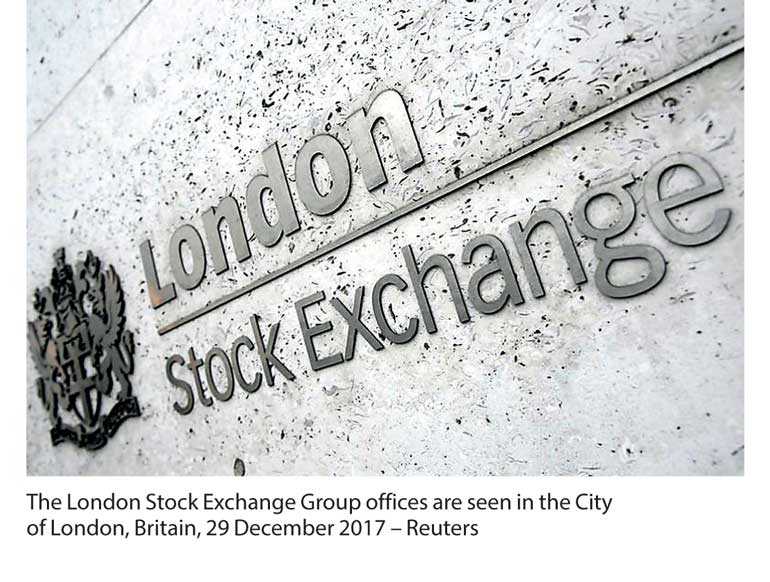Thursday Dec 12, 2024
Thursday Dec 12, 2024
Wednesday, 10 October 2018 00:00 - - {{hitsCtrl.values.hits}}
 London (Reuters): Europe battled to fend off a four-day losing streak for world stocks on Tuesday, after weary investors had seen Asia stumble to a 17-month low and bond markets hit by a fresh bout of selling.
London (Reuters): Europe battled to fend off a four-day losing streak for world stocks on Tuesday, after weary investors had seen Asia stumble to a 17-month low and bond markets hit by a fresh bout of selling.
Strength in oil stocks on higher crude prices and a rise in banking stocks on increased global borrowing had initially lifted Europe’s STOXX 600 index, but it was back near a 6-month low as the early momentum faded.
Italy’s benchmark 10-year government bond yield also moved toward a 4-12-year high as Economy Minister Giovanni Tria struck a resolute tone on his controversial budget plans in Rome’s parliament.
There was plenty more to keep the stress levels elevated.
The International Monetary Fund downgraded its global growth forecast on Monday for the first time since 2016.
Asian shares had then fallen to their lows after China briefly allowed its currency to slip past a psychological bulwark. Pakistan’s rupee slumped about 5% in an apparent devaluation ahead of what looks likely to be another IMF program.
“It all feels like it’s quite nervous here over whether things going to break (out of ranges) or not,” said Saxo Bank’s head of FX Strategy John Hardy.
He pointed to the rising U.S. and Japanese government bond yields which tend to set the bar for borrowing costs globally as well as the latest pressure on China’s yuan.
China’s central bank fixed its yuan rate at 6.9019 per dollar on Tuesday, so breaching the 6.9000 barrier and leading speculators to push the dollar up to 6.9120 in the spot market.
The drop should be a positive for exporters and did help Shanghai blue chips edge up 0.3%. Yet that followed a 4.3% slide on Monday which was the largest daily fall since early 2016.
Japan’s Nikkei fell 1.3%, hurt in part by a rise in the safe-harbour yen and as yields on Tokyo’s government bonds tested the 0.15% cap the Bank of Japan effectively has on them.
“Risk sentiment is in a foul mood and stocks are sinking everywhere,” JPMorgan analysts said in a note.
“With Chinese economic momentum continuing to weaken alongside increasing pressure from the United States, currency weakness is the obvious release valve,” they warned. “A lurch through the 7.0 level by year end is possible.”
A senior US Treasury official on Monday expressed concern at the fall in the yuan, adding that it was unclear whether Treasury Secretary Steven Mnuchin would meet with Chinese officials this week.
On Wall Street, futures were pointing lower again. The tech-heavy Nasdaq had fallen for the third straight day on Monday and growth stocks were pressured by worries rising bond yields might ultimately hobble the economy.
No safety net
Yields on 10-year Treasury paper notched a new seven-year top on Tuesday at 3.252%.
Treasuries have had a sort of safety net up to now as rising yields tend to dampen stocks and threaten the economic outlook, thus putting pressure on the Federal Reserve to go slow on policy tightening.
Yet recently the Fed has sounded so bullish on the economy and so hawkish on rates that the net has become frayed.
“The size and speed of the bearish bond impulse would suggest a collective shift in market thinking about the US growth prospects and policy projections,” said Damien McColough, Westpac’s head of rates strategy.
“The Fed’s expected 2019 profile has moved from just below 2 hikes to 2.5 hikes being factored-in.”
That shift has underpinned the dollar against a basket of currencies where it stood up 0.15% at 95.88, from a low of 93.814 a couple of weeks ago.
The dollar had less luck on the safe-haven yen, pulling back to 113.16 from a 114.54 peak last week.
The euro was undermined by political troubles in Italy and loitered at $1.1476, well off September’s $1.1815 top.
Italy’s borrowing costs have surged as a war of words between Rome and the European Union over the country’s budget plans escalated.
The yield on Italian government 10-year bonds hovered at 3.615%, just off February 2014 highs, while Italy’s FTSE MIB clawed up 0.3% having hit its weakest since April 2017 on Monday.
In commodity markets, gold got a modest safety bid at $1,191.10, having fallen 1.4% overnight. Industrial bellwethers copper and nickel jumped 1.4 and 2%.
Oil prices also rose as more evidence emerged that crude exports from Iran, OPEC’s third-largest producer, are declining in the run-up to the re-imposition of US sanctions and as a hurricane moved across the Gulf of Mexico.
Brent crude added 50 cents to $84.41 a barrel and US crude firmed 41 cents to $74.70.